|
July 13, 2012 
As the water receded from Lake Aldwell, the Elwha River returned to its historic channels, sediment was washed away and an ancient forest floor was revealed, along with pieces of our history. Before Elwha Dam was constructed in 1913, the banks of the Elwha River were home to the Klallam Tribe, European-American homesteaders, and the men who built the dam. When the Elwha Dam was finished and the Aldwell Reservoir filled, sacred places, cherished homes, and evidence of the early residents of the Elwha Valley were covered. Today it is possible to walk where Lake Aldwell once was, touch the stumps of ancient trees, and discover a community of new life. It is also possible to find pieces of history among the silt and sand. While it may be tempting to collect these remnants of times past, each of these artifacts is protected by law. These laws exist to protect our heritage and preserve the clues that can help tell the stories of our past. All artifacts found in the former reservoirs should be left in place and reported to the park. Park staff will evaluate each artifact to determine its historical significance. Artifacts of historical significance will be cataloged and accessioned into the park's curatorial collection which are available for researchers and display at park visitor centers or area museums. Artifacts recovered from the Elwha and Glines Canyon dam facilities are currently on display at the Clallam County Historical Society in Port Angeles, as well as at the River Story exhibit at the Port Angeles Library. In June, a citation was issued to a man for collecting a century old wagon wheel from the former Lake Aldwell, Department of the Interior property. More information can be found here. 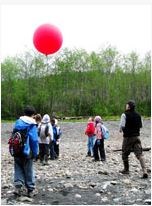
Port Angeles Library Experience Elwha River Restoration River Story events for the whole family continue at the Port Angeles Library this week. On July 13, at 7pm, Paul Chasman, singer, songwriter harmonica and guitar player will perform a concert of original songs at the Port Angeles Library, including "The Day the Dam Came Down," the song he wrote about the Elwha Dam Removal, and other songs on topics as diverse as dogs, cats, love, and Muhammad Ali. On Saturday, July 14 at 10am, kids and families can enjoy hands-on River Fun presented by NatureBridge. Travel through time to explore the history of the Elwha River, play with a river model to experience how river sediment is being affected by the removal of the dams, participate in balloon mapping and learn about other research being conducted along the Elwha River. Other opportunities to experience and learn about the Elwha River Restoration project can be found at the Feiro Marine Life Center, the Museum at the Carnegie, the Lower Elwha Klallam Tribal Center, Olympic National Park Visitor Center, and Hurricane Ridge Visitor Center. Download a 2012 Elwha River Restoration Brochure to learn more. 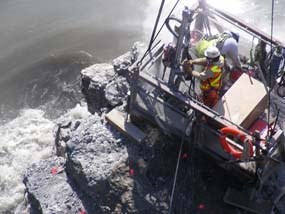
Courtesy of URS Corps July has been Explosive at Glines Canyon Dam The requested video is no longer available.
The requested video is no longer available.
July 6, 2012 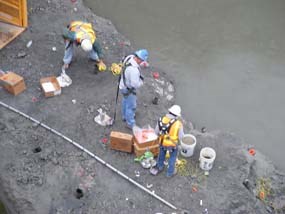
With the May-June fish window over, work to lower the Glines Canyon Dam resumed Monday, July 2. The first of five blasts scheduled for July took place on Monday, lowering the dam by three feet, and drawing down the reservoir from 514 to 511. A second blast took place on July 5, lowering the dam an additional three feet and drawing down the reservoir from 511 to 508. Three additional blasts are scheduled through the July 14. Each of these blasts is expected to lower the dam an additional 3 feet to a reservoir drawdown of 502. A fourteen day hold will begin after the fifth blast to allow the river time to meander back and forth across the newly exposed lake bed, eroding additional sediments downstream. During the fourteen day hold and August fish window, no additional work will be done to lower the dam. Blasting will be the primary method used to remove the remainder of the dam through the end of the project. Officials expect blasting to release large amounts of water from Lake Mills. Water elevation in Elwha River may increase by two feet. Increased flows may come in sudden surges and flows may remain high for up to five hours following each blast. Altair Campground is closed to the public through July 31 because of the potential risk along low-lying areas near the Elwha River. Visitors to the area should be aware of the possibility of sudden increases in river flow. River Music and Fun at the Port Angeles North Olympic Library June 21, 2012 
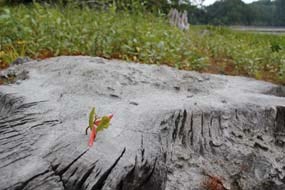
As the Elwha Dam came down, Lake Aldwell drained to reveal a barren landscape covered in up to 30 feet of lake sediments. Biologists predicted these nutrient poor sediments would slow the recovery of vegetation in the area. But as the reservoir changed back into a river and the river erodes the old lake sediments, an ancient forest floor has been uncovered, along with a promise of new life. Stumps of 500 year old cedars and rhizomes of once green ferns emerge from the sediment, testaments to the forest that shaded this land 100 years ago. The stumps and soil will likely prove to be fertile new homes for terrestrial plants taking root in this once aquatic habitat. Bands of rushes and willows circle the former edges of the lake, tracks of sandpipers and river otters crisscross the mud and sand, and frogs peek out from the algae growing in new ponds. Last year, over 30,000 seedlings were planted in the newly uncovered sediments of the old reservoirs. Over 400,000 additional seedlings will be planted over the next six years, helping along the process of natural revegetation. 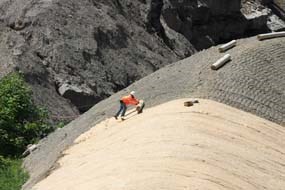
Work Continues on the Dams June 13, 2012 
The former Lake Aldwell reservoir is a great location to observe the changing landscapes along Elwha River. Land submerged beneath the reservoir is nourishing young plants for the first time in 100 years. Birds, frogs, and other wildlife are finding homes in the newly uncovered habitat. While this emerging landscape invites exploration, conditions are constantly changing and are hazardous in some locations. Stay as least 20 feet from the edge of riverbanks and use extreme caution when exploring. Riverbanks are actively eroding and may be unstable. Although the Lake Aldwell and Lake Mills deltas are open to the public, visitors are reminded that the Glines Canyon Dam and the former Elwha Dam site are still active construction areas and are closed to all public entry. Upcoming Closures There will also be a safety-related closure of Altair Campground July 2- 31. Contractors will use a series of controlled blasts to lower the Glines Canyon Dam in July, necessitating the closure. The controlled blasting will result in more a sudden water release than the hydraulic hammer previously used to remove Glines Canyon Dam. While the month of July is a popular time for the campground, it is the only month during the summer season when work to lower the dam will not be restricted by fish windows. The campground will close on the evening of July 1 and will remain closed through the entire month. More... 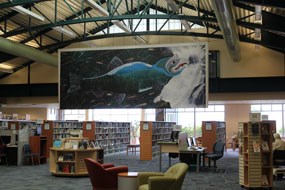
Discover River Story Elwha Makes International News! May 25, 2012 While workers continue to remove concrete from Glines Canyon Dam, artists, librarians, park staff and volunteers are busy putting the finishing touches on River Story, the summer-long exhibit of art and science at the Port Angeles branch of the North Olympic Library System. Check the library's website, and stop back here soon to learn more about the exhibit and the full schedule of public events that will be part of it. May 18, 2012 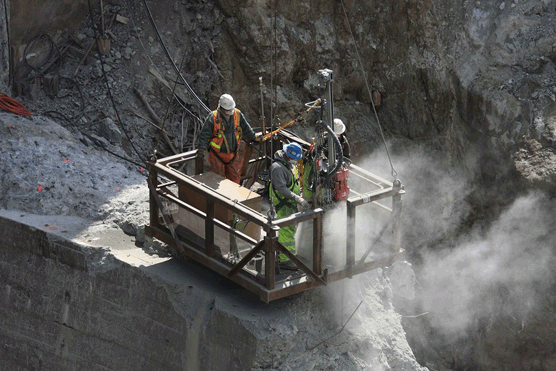
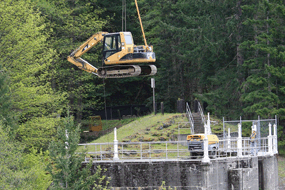
Although work to lower Lake Mills was halted on May 1 for the May/June fish window, there is still a lot of activity at the site. Last week the barge, excavator and hydraulic hammer were hoisted from Lake Mills. This week the surge tank came down and a section of the dam above the water line was shot with explosives to remove the remaining concrete. The first of two shots planned for this week occurred last Saturday afternoon. While the explosions themselves are over in less than two seconds, each shot takes days of preparation. The layout of the explosives and the timing for the shot are carefully designed by a blast specialist. According to the design for each shot, 30-60 holes are drilled into the concrete then filled with dynamite and packing material. At the moment of the blast, each explosive has its own timing. The timing and location of the explosives are designed to remove a specific size of concrete and force the concrete to fall into the reservoir behind the dam. Once the blast is over, it's time for the clean-up. The dam removal contract requires that all concrete be removed from the Glines site, so as the reservoir drains the chunks of concrete will be carefully removed from the park. A total of three shots will occur during the May/June fish window to remove pieces of the dam above the water line. In July, demolition of the dam below the waterline will continue. Twenty-one additional shots are planned from July until the end of the dam removal. Blasting will be the primary tool used to lower the dam for the remainder of the demolition. The requested video is no longer available.
The requested video is no longer available.
Protecting the Fish In truth, the sediment being released as the dams come down does create harsh conditions for most fish. The sediment release and its impact on native fish species was one of the fisheries managers' greatest concerns during the planning process. To mitigate the impact of the sediment being released into the river and facilitate the return of salmon and steelhead to areas upstream of the dams during the dam removal, the Elwha River restoration plan includes the use of fish windows. During the fish windows, work that would lower the river channel is halted. As no new sediment is eroded, the amount of suspended sediment in the river decreases, allowing adult fish to enter the river and juvenile fish to safely move to sea. Depending on the species, some adult fish are collected and moved upstream of the Elwha dam site and into the clean water of Little River or Indian Creek. Last fall biologists moved 600 Coho salmon into Little River and Indian Creek and this spring 21 adult steelhead were moved into Little River. Although removal of the dams is still ongoing and it will be another three to five years until the Elwha River returns to natural sediment conditions, spawning of both Coho and steelhead has been observed; and this spring newly emerged juvenile Coho were seen swimming in Little River and Indian Creek for the first time in 100 years. May 4, 2012 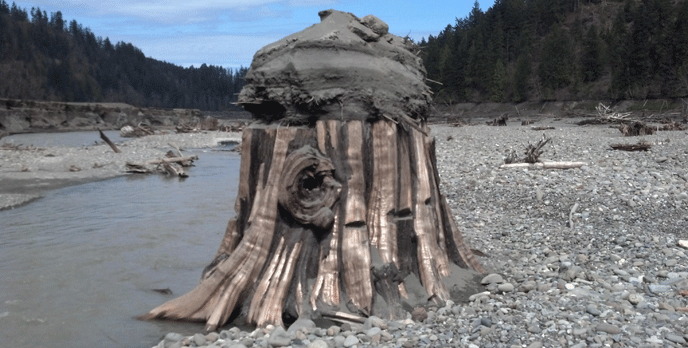
NPS Photo by Andy Ritchie 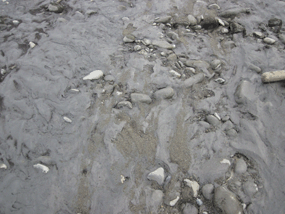
NPS Photo by Andy Ritchie The May-June fish window went into effect last Tuesday, and all in-water and sediment-releasing work is on hold for two months. Barnard crews are still busy though, working at the former Elwha Dam site to restore the area's original landscape contours. (The original lines of the canyon that once existed just upstream of the dam site are gone, however, as the rock walls were blasted to help plug the hole created after the dam blew out shortly after initial completion in 1913.) Lake Aldwell is gone, and the Elwha is now functioning as a river as it courses through the old lake bed. As the river's flow returns, it is actively eroding and transporting accumulated lake bed sediments downstream. Much of the fine sediment is being carried well out into the Strait of Juan de Fuca. Some of it is being redeposited in calm areas along the lower river and the sediment team is finding the beginnings of fine-grained beaches forming at the river's mouth. Warm temperatures and rain led to high flows in late April when the river reached its highest flows since early January, leading to the highest sediment loads yet since dam removal began. With the fish window in place and the summer's typical low flows ahead, geologists predict the river's turbidity to drop until the fall rains arrive later this year. More on recent high flows. At Glines Canyon, explosives technicians will begin drilling holes into the remaining above-water sections of the dam next week. Once the holes are finished, they will be packed with explosives in preparation for a carefully designed controlled blast. Additional controlled blasts or 'shots' are scheduled for the coming weeks as crews incrementally remove the above-water concrete. 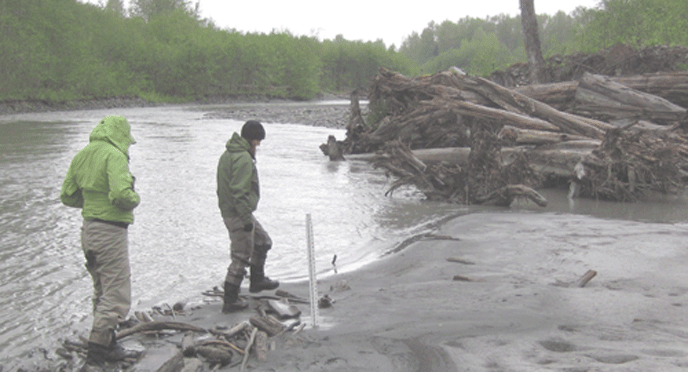
NPS Photo by Andy Ritchie Changing Scene 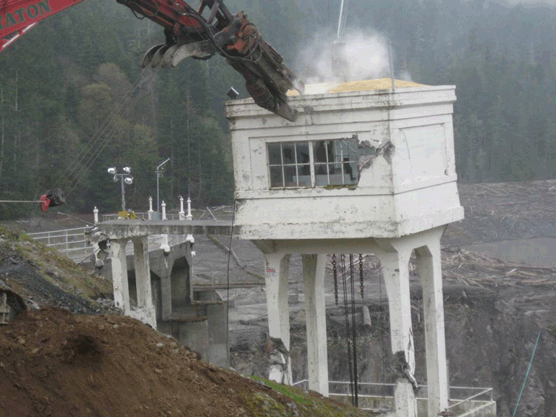
As May 1 and the spring fish window approach, Barnard's crews are working hard to lower the river channel through the former Elwha Dam site. Although the river has been flowing through its native channel for several weeks now, large rocks and other debris still line the floor of the channel. Crews are slowly excavating the remaining debris that was used to plug the bottom of the dam after it blew out in 1912. The hydraulic hammer that's been used since September to chip away at the Glines Canyon Dam was repaired last week, but will not return to its dam-removal activities. When mechanics examined the damaged hammer during repairs, they found wear patterns indicating that the hammer had reached its capacity to work from the floating barge. So workers have begun the process of relocating the excavator and dismantling and removing the barge from Lake Mills. With the fish window beginning May 1, all in-water work must stop. During the fish window, contractors will use explosives to remove the sections of dam that are above the water level. Once the fish window ends on June 30, contractors will return to lowering Glines Canyon dam, using controlled and incremental blasting, rather than the hammer. 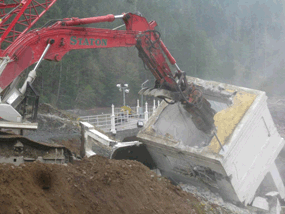
As these photos illustrate, the old Glines Canyon Dam headgate house was removed this week. This one-room structure once housed the controls that regulated the amount of water entering the penstock (large pipe) and powerhouse from the reservoir. Click here for a site plan of the historic Glines Canyon dam and hydroplant, courtesy of the Historic American Buildings Survey/Historic American Engineering Record. Previous entries from 2012 and 2011 can be found in the archives here. |
Last updated: April 25, 2023
